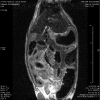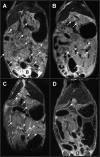Hyaluronic acid-paclitaxel: antitumor efficacy against CD44(+) human ovarian carcinoma xenografts
- PMID: 17603630
- PMCID: PMC1899257
- DOI: 10.1593/neo.07229
Hyaluronic acid-paclitaxel: antitumor efficacy against CD44(+) human ovarian carcinoma xenografts
Abstract
Numerous human tumor types, including ovarian cancer, display a significant expression of the CD44 family of cell surface proteoglycans. To develop tumor-targeted drugs, we have initially evaluated whether the CD44 ligand hyaluronic acid (HA) could serve as a backbone for paclitaxel (TXL) prodrugs. HA-TXL was prepared by modification of previous techniques. The in vitro cytotoxicity of HA-TXL against the CD44(+) human ovarian carcinoma cell lines SKOV-3ip and NMP-1 could be significantly blocked by preincubation with a molar excess of free HA. Female nude mice bearing intraperitoneal implants of NMP-1 cells were treated intraperitoneally with a single sub-maximum tolerated dose dose of HA-TXL or with multiple-dose regimens of paclitaxel (Taxol; Mead Johnson, Princeton, NJ) to determine the effects of these regimens on host survival and intraperitoneal tumor burden, with the latter being assessed by magnetic resonance imaging. NMP-1 xenografts were highly resistant to Taxol regimens, as host survival was only nominally improved compared to controls (T//C approximately 120), whereas single-dose HA-TXL treatment significantly improved survival in this model (T//C approximately 140; P = .004). In both NMP-1 and SKOV-3ip models, MR images of abdomens of HA-TXL-treated mice obtained shortly before controls required humane sacrifice revealed markedly reduced tumor burdens compared to control mice. This study is among the first to demonstrate that HA-based prodrugs administered locoregionally have antitumor activity in vivo.
Figures




Similar articles
-
Metronomic activity of CD44-targeted hyaluronic acid-paclitaxel in ovarian carcinoma.Clin Cancer Res. 2012 Aug 1;18(15):4114-21. doi: 10.1158/1078-0432.CCR-11-3250. Epub 2012 Jun 12. Clin Cancer Res. 2012. PMID: 22693353 Free PMC article.
-
Magnetic resonance imaging-based prospective detection of intraperitoneal human ovarian carcinoma xenografts treatment response.Int J Gynecol Cancer. 2006 Jan-Feb;16 Suppl 1:111-7. doi: 10.1111/j.1525-1438.2006.00502.x. Int J Gynecol Cancer. 2006. PMID: 16515577
-
Hyaluronic acid-paclitaxel: effects of intraperitoneal administration against CD44(+) human ovarian cancer xenografts.Cancer Chemother Pharmacol. 2011 Jul;68(1):107-16. doi: 10.1007/s00280-010-1462-2. Epub 2010 Sep 17. Cancer Chemother Pharmacol. 2011. PMID: 20848284
-
Role of versican, hyaluronan and CD44 in ovarian cancer metastasis.Int J Mol Sci. 2011 Jan 31;12(2):1009-29. doi: 10.3390/ijms12021009. Int J Mol Sci. 2011. PMID: 21541039 Free PMC article. Review.
-
Innovative therapy of ovarian cancer based on overexpression of CD44 receptor.Ginekol Pol. 2015 May;86(5):388-91. doi: 10.17772/gp/2428. Ginekol Pol. 2015. PMID: 26117979 Review.
Cited by
-
Ovarian cancer stem cell markers: prognostic and therapeutic implications.Cancer Lett. 2012 Sep 1;322(1):1-7. doi: 10.1016/j.canlet.2012.02.002. Epub 2012 Feb 11. Cancer Lett. 2012. PMID: 22334034 Free PMC article. Review.
-
Modulation of hyaluronan production by CD44 positive glioma cells.Int J Cancer. 2010 Aug 1;127(3):532-42. doi: 10.1002/ijc.25085. Int J Cancer. 2010. PMID: 19957333 Free PMC article.
-
Chemotherapy-induced hyaluronan production: a novel chemoresistance mechanism in ovarian cancer.BMC Cancer. 2013 Oct 14;13:476. doi: 10.1186/1471-2407-13-476. BMC Cancer. 2013. PMID: 24124770 Free PMC article.
-
Methodology of predicting novel key regulators in ovarian cancer network: a network theoretical approach.BMC Cancer. 2019 Nov 21;19(1):1129. doi: 10.1186/s12885-019-6309-6. BMC Cancer. 2019. PMID: 31752757 Free PMC article.
-
Intraperitoneal delivery of platinum with in-situ crosslinkable hyaluronic acid gel for local therapy of ovarian cancer.Biomaterials. 2015 Jan;37:312-9. doi: 10.1016/j.biomaterials.2014.10.039. Epub 2014 Oct 24. Biomaterials. 2015. PMID: 25453960 Free PMC article.
References
-
- Fields MM, Chevlen E. Screening for disease: making evidence-based choices. Clin J Oncol Nurs. 2006;10(1):73–76. Review. - PubMed
-
- Morrison J. Advances in the understanding and treatment of ovarian cancer. J Br Menopause Soc. 2005;11(2):66–71. Review. - PubMed
-
- Parazzini F, Chiaffarino F, Negri E, Surace M, Benzi G, Franceschi S, Fedele L, La Vecchia C. Risk factors for different histological types of ovarian cancer. Int J Gynecol Cancer. 2004;14(3):431–436. - PubMed
-
- Greimel ER, Bjelic-Radisic V, Pfisterer J, Hilpert F, Daghofer F, du Bois A Arbeitsgemeinschaft Gynaekologische Onkologie Ovarian Cancer Study Group, author. Randomized study of the Arbeitsgemeinschaft Gynaekologische Onkologie Ovarian Cancer Study Group comparing quality of life in patients with ovarian cancer treated with cisplatin/paclitaxel versus carboplatin/paclitaxel. J Clin Oncol. 2006;24(4):579–586. - PubMed
Publication types
MeSH terms
Substances
LinkOut - more resources
Full Text Sources
Other Literature Sources
Medical
Miscellaneous
